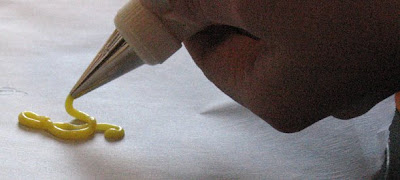Do you ever have one of those days when the recipe you are making keeps having issues...and then you correct them in time but end up losing so much time? I had that kind of day making this pie.
I wanted to bring this pie with us to a dinner party the same evening. Since I'd already made this pie once before as a tart, I didn't think it would be difficult and so I started at about 3 pm, thinking it would be ready by about 4:30 with plenty of time to cool before we left at 5:15.
The first mistake I made was in choosing a pie plate. I should have gone with something pretty flat...maybe 1 1/2 inches high. Instead I went with a beautiful white ceramic plate that was about 2 1/2 inches high. I used the already made pie dough circle which I had remembered to take out of the fridge a while before...so that part was fine. Then I made my first mistake by putting it into the freezer. I often do that with single crust pies before blind baking because it helps to keep the dough from shrinking during baking. The part I forgot was that you don't do that with ceramic or glass pie plates. Going from freezer to hot oven works fine with metal plates, but not glass and ceramic! Fortunately I remembered after I took it from the freezer and before I put it in the oven! Let it sit awhile to warm up a bit, added parchment and my baking lentils (pie weights) and blind baked it. So far so good!
The next mistake was in not adjusting the recipe for a thicker filling. I needed twice as much filling for a pie 2 1/2 inches high. That includes having more room temperature eggs and butter, more ground almonds, and all the filling ingredients really. Fortunately I had an extra egg at room temperature and I used all the butter in the two butter dishes because that butter was at room temperature. The ground almonds almost ran out before the measuring cup was filled, but there was just enough! Another disaster averted. As you can see from the slice above, I really needed all that filling. The recipe below has been adjusted so the filling is what you see in the photo above.
The final mistake was not realizing that a thicker filling would require a longer baking time. Again, I was fortunate because I had the time I'd allowed for cooling...and I used it all! The pie went from the oven to the carrier. Once we got to our destination I asked the hostess to put the pie in the fridge to cool while we visited and ate. Even so, the very center was a bit warm.
Was it worth it? Yes! It was an awesome pie, everyone loved it and offers to leave some for the hosts were accepted (which is not always the case). Sweetie and I enjoyed a slice last night to finish it off.
I made this with fresh apricots which I blanched and peeled. You can also use canned apricot halves and still have a delicious pie. The fresh apricot season is pretty short so it's nice to know that there is another option. Of course you can also use another fruit with the frangipane filling...anything that goes well with almonds will work well...fresh pitted cherries, especially sour cherries would be awesome a would most berries.
The apricot jam on the bottom crust and on the tops of the apricots after baking (for shine) really is optional, but you do get a bit more apricot flavor that way.
Apricot Frangipane Pie
Pillsbury Readycrust or similar packaged pie dough circles, as I did
1/4 cup apricot jam, warmed (optional)















































